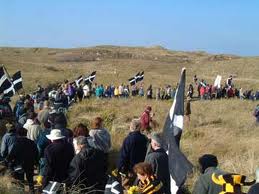A Wholly Holy Month is March
By Veronica MacDonald Ditko
An Accidental Anthropologist
March is a saintly month. Western Europe hosts lots of celebrations during the month from Ireland’s St. Patrick to Sicily’s San Giuseppe. And we mustn’t forget Wales’ St. David and Cornwall’s St. Piran (or Perran).
These probably all stem from celebrations for the spring equinox, which this year falls on March 20. The equinox hailed in the springtime, a time of renewal and rebirth, a time of high hopes for the spring and summer bounty.
St. Piran is someone we rarely hear about here in Jersey. He is the patron saint of tin-making. The legend goes that he lived in Ireland in the 6th Century, but was tied to a mill stone and thrown into a stormy sea by non-believers. The sea calmed and he floated to safety on the shores of Cornwall at Perranzabuloe. He first Christianized the animals there. He also founded the Abbey of Lanpiran and served as abbot, for people of course. (Notice, all these names contain his name!)
St. Piran actually shares a day with Saint Ciarán (or Kieran) of Saighir, which some scholars say is the same person.
Today, the week leading up to St. Piran’s Day, March 5, is called Perrantide in Cornwall, the most southwesterly point in England.
Perranporth village hosts the Lowender Peran festival, which is dubbed an inter-Celtic celebration and includes other saintly celebrations like St. David. This year the schedule looks like a lot of eating, drinking, and most of all, singing. But since a common phrase in the 19th Century was “drunk as a perraner,” I think I know what activity will probably win out.
 On March 5, St. Piran’s Day, many thousands of people march across the dunes to his cross where his abbey once was. They dress in the colors of St. Piran’s flag – black, white and gold. Sometimes plays are put on about St. Piran.
On March 5, St. Piran’s Day, many thousands of people march across the dunes to his cross where his abbey once was. They dress in the colors of St. Piran’s flag – black, white and gold. Sometimes plays are put on about St. Piran.
The best part about the celebration this year is that his chapel, or what is called an oratory, will soon be revealed. Plans to excavate it began in June thanks to a grant from the Heritage Lottery Fund, Cornwall Heritage Trust, Cornwall Council, HRH Prince of Wales Duke of Cornwall. The chapel was buried in sand in the 1980s. It is believed to be the oldest Christian building on mainland Britain.
Best of all, there is an online petition to make St. Piran’s Day a bank holiday in Cornwall. You should vote!
If you can’t make it to England for the celebration, you can always go to Grass Valley, California where they celebrate it too. Their recent claim to fame is the Pastie Olympics Event where Cornish Pasties are flung at a St. Piran’s Flag. The person with the best two out of three pastie tosses gets the trophy. Dogs get prizes too by lapping up the smashed pasties.
For something a little closer to home, the Cornish Heritage Society East will celebrate St. Piran’s Day March 3 at noon the Wharton United Community Church at St. John’s in Wharton, Morris County, NJ. You can eat pasties and saffron cake, but please don’t hurl them at a flag. More info: www.cornishcrier.com.
Veronica MacDonald Ditko is originally from the Jersey Shore, but married and settled in northern New Jersey. Her journalism career started a decade ago after studying Psychology and Anthropology in Massachusetts. She has written for several newspapers and magazines including The Daily Hampshire Gazette, The Springfield Union News and Sunday Republican, Happi, Chemical Week, The Hawthorne Press, The Jewish Standard, Suite101.com and more.
